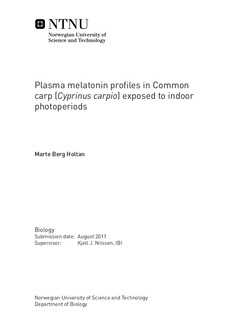| dc.description.abstract | An intervention against extreme poverty and hunger was introduced in year 2000, when all members of the United Nations agreed on the Millennium Development Goals (MDG). Today, 1.4 billion people live in poverty and hunger, with poor prospects for increased living standards. Nepal is one of the world s poorest countries with most of its population living ruraly on low-income agriculture. Due to ongoing climatic changes and financial instability, the international food security is threatened. Inexpensive and low water consuming food production will therefore be an important development for times to come. In line with the MDGs, the NTNU initiated programme Sustainable Poverty Reduction in Nepal (SPRN) have started to utilize Nepal s rich freshwater resources to develop fish farms in tandem with eco-friendly hydropower projects. The main target is to develop year-round delivery of carp fingerlings in hilly rural areas.Fish are seasonally breeding animals that use environmental signals to coordinate and control their biological rhythms. Photoperiod represents an accurate indicator of time of day and season, and may be translated into a chemical body signal, melatonin, by the pineal gland. Pineal melatonin is released during night and the secretory pattern which reflects the environmental light/dark cycle may exhibit one of three known patterns. A daily and annual rhythmic production of melatonin may provide the fish with a physiological capacity to anticipate and prepare for upcoming seasonal changes. Manipulation of the photoperiodic control of pineal melatonin release has been successfully used to initiate biorhythms like spawning in cultured finfish species at mid and high latitudes. The current study was performed to describe the day/night plasma melatonin levels in Common carp (Cyprinus carpio) during November at mid-hills Nepal (28 ºN). It represents the first part of possible development of a maturation control system for low latitude carps. Plasma melatonin levels exhibited a single peak profile during late darkphase and decreased to low daytime levels before the onset of light. When subjected to an extended night period, carp plasma melatonin rhythm appeared to repeat this profile from natural photoperiod, which may indicate a circadian clock system at work. Blood plasma cortisol levels were elevated during these experiments but are not expected to have stimulated the melatonin release. These results demonstrate a possible complex melatonin control system of type B in the Common carp kept at low latitude (Nepal). | nb_NO |

